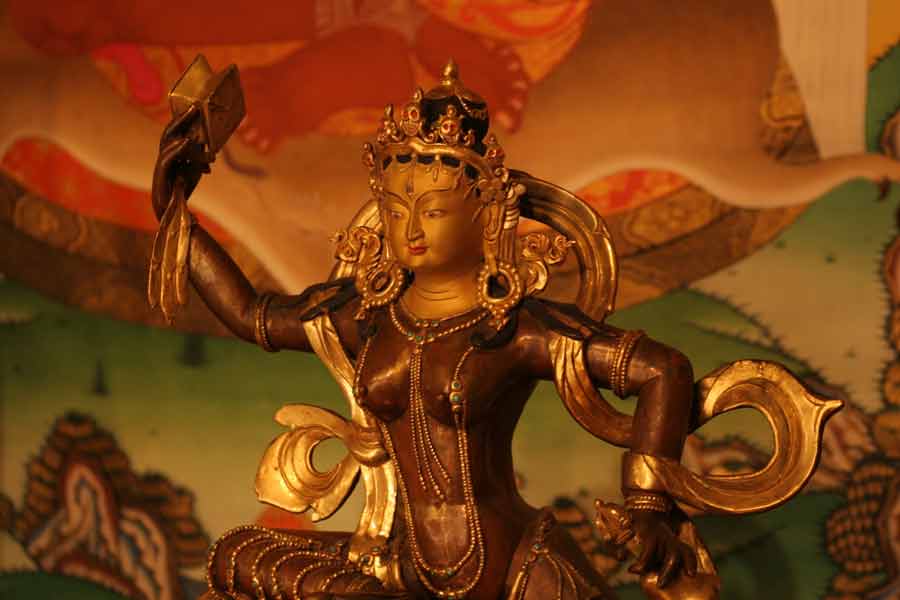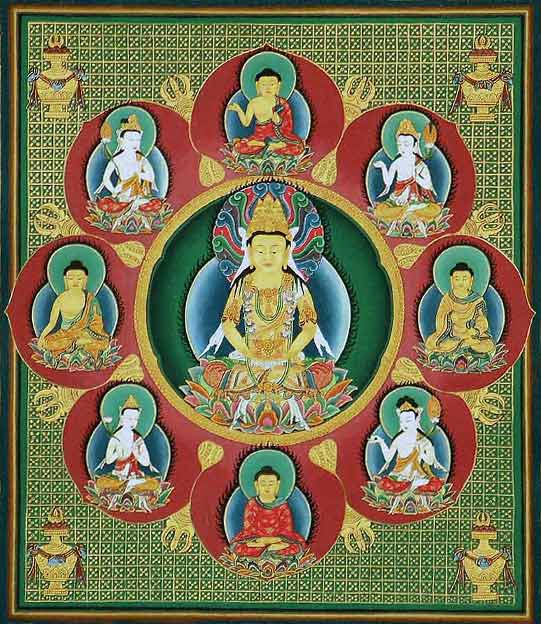
Machig
Every moment in your life is experience. This experience unfolds in infinite ways, as the natural mandala of life, and in this mandala the mind that
experiences is the deity. Deity here means pure and perfect, worthy of respect and sublime in nature. Everyone else is like that too, every other person in
your life, every cat, dog and insect, even the plants and the stones. At the same time, everything that unfolds within experience are like reflections in a
mirror. The reflections are not in the mirror, they didn’t enter the mirror and they don’t leave again. No thing arises, no thing remains, no thing ceases.
One aspect is called form, the other is essence. In vajrayana, they are called the superior two truths. To experience this for
real, we need the vajrayana view. An approach is necessary, an entrance door. That entrance door is called empowerment. Empowerment introduces us to what
we really are, and this insight can widen through twenty-five levels, different ways of combining form and essence.
Perhaps you are the type who likes to live in a neat and tidy environment, or maybe the type who relaxes with a cup of coffee before cleaning the dishes.
Maybe you want everything clean and tidy before relaxing. Maybe you don’t care at all, because it makes no difference to you. The combinations are between
your form and your essence, how life looks like and how you feel. The combinations are endless. In Vajrayana they are endless too, but there are
twenty-five with names.
When we hear about Vajrayana, the Buddhist teachings of the most esoteric type, it should not be generalized to much, as if it was one uniform set.
Vajrayana covers a lot of territory with many different sceneries. The starting point of all of these areas is empowerment, being blessed, inspired and
introduced to the way reality is. The view in Vajrayana is this understanding of reality, how to realize it and the incredible qualities that unfold after
realization.

Taizo-Kai Mandala
Most readers are familiar with the viewpoints known as impermanence, suffering, egolessness, dependent origination and shunyata, descriptions of
our everyday reality in each moment. What about Vajrayana, what is the view here? It can be subsumed under one statement: all that you see, hear or feel
are in reality three aspect of the awakened state. The Tibetan meditation master and philosopher Longchenpa said that a person suffering from
jaundice sees a conch shell as yellow and when they have recovered, the conch shell is seen as white. Did the shell change color? It is the same with the
distorted worldview of believing that everything is permanent and that our life is made out of singular entities, centered around a personal identity, me.
We need to enter a more open-minded and honest way of experiencing, seeing things as they are. This transition is often called getting the view right, and the finer and higher the view, the closer we are to seeing reality without filter or preconceived ideas, like having
fully recovered from jaundice.
In Vajrayana there is more than one level of understanding reality, sometimes three, sometimes five, sometimes twenty-five. All are clearly defined,
distinct, and each of them describe clearly what we are, what we experience, our body and mind, and the world we live in. My teacher Tulku Urgyen Rinpoche
introduced me to these in a linear fashion and I would like to share them here in brief, just the perspectives, not the practices. There are five basic
perspectives: the view of Kriya Tantra, Yoga Tantra, and of Mahayoga, Anuyoga and Atiyoga. They can be combined with each other into twenty-five different
combinations. A meditator can go through these twenty-five steps and will do so, whether one has learned them or not, in order to awaken truly and
completely. In fact, the tantras exist to present the magical keys that unlock these twenty-five levels of realization.
The discovery of an uncomplicated way of being that is both gentle and aware, lets you open up even further. This is the direct outcome of bodhisattva
training, your gentle heart combined with the increasing sense of seeing that what used to be held in mind does not really exist. Seeing the absence of
something to fixate on, loosens the mind to open further. This gentle openness of mind is not yet the awakened state, but it brings tremendous inspiration
and a sincere yearning to grow closer to the real inner buddha. This is the basic view in Kriya Tantra, as it dawns in your mind through practice.
Growing more and more familiar with visualizing the awakened state in the form of a buddha that blesses and inspires you to acknowledge your fundamentally
perfect qualities, lets you experience a deepened self-assurance that, yes, everyone including this mind has the same nature as a buddha. You feel
this, not as a theory, but in actuality, that you belong to the same family: it is only a matter of growing into it more fully. This is the essential view
in Yoga Tantra, as it is experienced through practice.
The process you are going through is one of gradually approaching the qualities and the grace of the awakened state, expressed in visible form, audible
sounds and sublime imaginations, all of which are intangible, but undeniably yourself at your very best, the open heart of boundless kindness. The need to
seek from elsewhere the source of grace, compassion and intelligence, gradually lessens at exactly the same pace as you acknowledge that these qualities
are already present within the nature of your mind. At this point you automatically arrive in the tremendously expansive and colorful perspective of the inner tantras. You are now perfectly positioned to go beyond one-sided awareness into the directionless knowing of the nature of mind. This
experience, the entrance gate to the inner tantras, is pointed out to you by a true wisdom teacher. The sense of separateness and distancing yourself from
the awakened state is left behind each time you practice, so you enter the experience of the inner tantras. Your basic reference has become the nonduality
of form and essence, also known as the superior dharmakaya of the indivisible two truths, the beginning and end of everything. Together with
having suspended dualistic mind within the vastness of nondual awareness, you experience that the ordinary distorted projections can be vacated so that the
mandala of the environment and yourself as the deity are not separate; they are yourself and your field of experience. There is a tremendous appreciation
of the richness and diversity of this self-existing mandala, while at the same time everything is oneness, the single identity of the awakened state. This
is the essential view in Mahayoga, as it is experienced through practice.
While environment, body and mind are essentially all mind, it is the emphasis on one aspect that reveals three types of mandala perspectives, corresponding
to the three inner tantras. In Mahayoga the mandala is your environment, in Anuyoga the mandala is your body, and in Atiyoga the nature of mind is the
complete and perfect mandala.
Up to this point your journey has been twofold: an accumulation of tremendous spiritual wealth and a shedding of dualistic habit-display. This leads you to
be nearer reality in its naked state. Your physical-magical embodiment, the deep mystery of your voice, and the play of your spacious wakefulness are
revealed more and more, from your own being. Each moment of perception, hearing a voice or the rustling of leaves, knowing and feeling, all unfolds within
the sacred and natural mandala that is your body, an amazing city of channel-wheels, energy currents and magical essence-spheres. This is the essential
view in Anuyoga, as it is experienced through practice.
Growing completely familiar with this perspective through the yogas, mastery is the sacred embodiment of a buddha, manifest enlightenment is every
deed, untainted like a lotus flower. That is the meaning behind bowing at a master’s lotus feet.

Golden Wheel Of Dharma statue
Kalimpong Karmapa monastery West Bengal India
When all knots are untied, all stray energies returned to the central channel, and mind remains as the spaciousness of greatest ease, you have no choice
but to enter the gateless gate of primordial awakening, the matchless view of Atiyoga. This depends on having opened up until you can open up no further.
Your teacher is awakened mind, essentially, and so are your fellow yogis and yoginis. The instruction and its practice is no other than awakened mind. The
environment, the deity, the mantra and samadhi are all awakened mind as well. This is the essential view in Atiyoga, as it is experienced through practice.
To illustrate the view of Atiyoga, here is an excerpt from the Kulayaraja Tantra:
It was then that Vajra Being, remaining as this single vastness of the sphere, arose,
And in the presence of the All-Creating King, Awakened Mind,
With joyful spirit, his face all jubilant, took seat.
The All-Creating King, Awakened Mind,
Addressed the Vajra Being in these words:
Vajra Being, emaho, how wonderful!
With joy your mind is filled, how wonderful!
Your face all jubilant, how wonderful!
And yet you sprung from me, how wonderful!
The Vajra Being then put forth these words:
Hear me, teacher of all teachers, All-Creating King,
Is my teacher not this sphere, beyond all constructs?
Is the retinue as well no other than this unconstructed sphere?
Is the doctrine also not this unconstructed sphere?
Is the time and place not other than this unconstructed sphere?
When everything is of the nature of this sphere,
Then why, o teacher of all teachers, do you take the role of teacher?
And why are you encircled by this retinue?
How come you teach the doctrine to this retinue?
And how, as well, are time and place all one?
To Vajra Being, in these very words,
The All-Creating King, Awakened Mind, then spoke:
Great Being, listen, keep these sounds in mind,
Through sounds I shall here clarify the meaning, so listen Mahasattva.
As I, the All-Creating King, awakened mind itself,
The essence of all dharmas, everything,
Am a timeless sphere, an essence beyond constructs,
Thus, this unconstructed nature, this primordial dimension,
This timeless sphere, this self-existing state,
Is the teacher and the teaching, and the retinue, the time and place,
And so I teach this sphere to be my nature.
It is wonderful indeed that the buddhas respond to different attitudes and abilities by teaching meditators to move forward from where they are. There is
always a level of practice that suits you, which is a great kindness and very practical. As you go deeper and realize more, another amazing perspective
opens up and then another, until your trans-panoramic experience is equal to that of every awakened being. As of today while Vajrayana is still new in the
English language, we are all greatly enriched by understanding Vajrayana’s twenty-five ways of practice. All twenty-five share the same essence of oneness,
the indivisible single sphere of dharmakaya, which is the awakened mind of all buddhas. May it be realized.
In the ninth century the Tibetan child genius, Vairotsana, traveled to India where he received the teaching on the twenty-five tantric views in Bodh
Gaya from the outstanding master Shri Singha. Vairotsana brought back this wonderful perspective in written form, which is included form, Vairotsana’s
Collected Tantras. Like a few drops from the vast ocean, this article with my humble reflections on the wondrous mystery we call life, is based on
Vairotsana’s old scripture combined with the oral teaching of Tulku Urgyen Rinpoche.